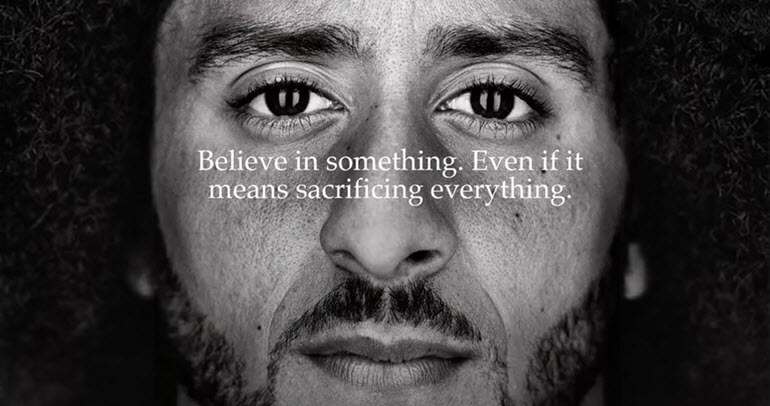
Nike recently marked the 30th anniversary of its iconic “Just Do It” campaign by launching new ads featuring NFL player Colin Kaepernick, a move that instantly raised controversy online. Numerous notable sportspeople, such as LeBron James and Serena Williams, joined hundreds of thousands in supporting the advertising and Kaepernick’s broader cause. However, those opposed to Kaepernick and the practice of kneeling during the national anthem at football games reacted strongly as well, with many calling for a boycott of Nike, and some even taking to destroying their Nike gear.
While there is certainly much to debate regarding Kaepernick and his cause, and probably less so regarding the questionable logic of destroying merchandise that Nike has already collected revenue on, this article is not about that. As somebody who oversees millions of dollars of brand market research every year, my curiosity was piqued: Would this prove to be a genius move or PR disaster for the brand strategists at Nike? And so to answer this burning question, the consumer goods & retail research division of Escalent went into field to survey public opinion.
There’s a lot at stake
The Nike brand and its long-time agency of record, Wieden+Kennedy, are no strangers to addressing social issues or courting controversy with advertising, and many will recall contentious ads featuring other sports stars such as Tiger Woods, Eric Cantona or Charles Barkley.
But when you’re working with a brand as valuable as Nike, intentionally courting controversy is a high-stakes bet. Forbes values the Nike brand at $32 billion, placing it firmly in the Top 20 most valuable brands worldwide, and ahead of other notables such as Walmart, Budweiser and Pepsi. Knocking just a few percentage points off that value would undoubtedly leave shareholders growling. Which is exactly what everybody from the president to media pundits have been predicting, that Nike will rue this decision and pay a heavy financial price.
If that’s not enough of a tinderbox to set ablaze, consider for a moment that with this ad, Nike is also turning one of the sporting world’s largest sponsorships into a very messy three-way relationship. Earlier this year, Nike extended its massive multi-billion dollar sponsorship of the NFL, making it the official clothing supplier to America’s biggest sport for a further eight seasons. Yet this is the same NFL that Kaepernick is currently in a protracted legal battle with as he seeks to prove that the league colluded against him to keep him off the field. Yes, things just got a lot more complicated.
With all of this in mind, is the old saying true, that there’s no such thing as bad publicity? Let’s find out.
What’s in the data?
The research looked to understand three things: The public awareness of the Nike advertising, their sentiment towards it, and what their potential reactions to it might be. The topline results were very interesting.
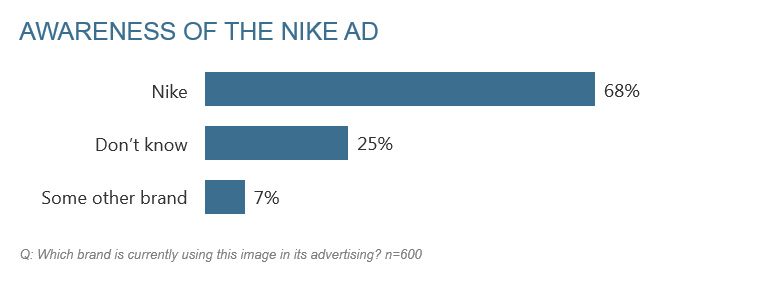
Awareness of the Nike ad is exceptionally high, especially considering that this research ran in the two days after the ad was released. Within 48 hours, more than two-thirds of Americans were able to correctly identify that the ad belonged to Nike, and there was also very little confusion with other brands. Supporting this finding, Bloomberg reported that the media coverage and social media reaction created $43 million worth of buzz in less than a day. Nike brand strategists would undoubtedly consider this rapid uptake in awareness and resulting buzz as a major win.
But what was the sentiment towards the ad? Turns out that much like our political spectrum, it was split three ways. Slightly more than a third of respondents had a negative reaction to the advertising, while slightly less than a third had a positive reaction, with a further third in the middle felt neutral.

So the question is whether Nike should be concerned about the 38% that have a negative sentiment? The answer: Probably not.
When asked about their anticipated reactions to the Nike ad, more than half of respondents didn’t anticipate having any reaction to it. And as for the 38% with negative sentiment, well a good portion of that doesn’t translate into action. Only one in five said that they anticipated that they would boycott Nike products, and just 4% said that they would destroy the Nike products that they own.
This is Nike’s calculated gamble—it will have anticipated the potential of a boycott, but will have weighed the potential exposure and buzz as far more valuable in the long term versus the potential short-term losses of a boycott. That’s because boycotts very rarely have a sustained impact, as you can see from looking around and noting that Starbucks and Chick-fil-A are still in business and successful, or that Netflix, Jimmy Kimmel and Laura Ingraham are still on your TV and entertaining millions.

Dig a little deeper, and you can see Nike’s real motivations
But something that makes the Nike brand considerably different from many other consumer brands is that its target market is very skewed when it comes to age. More than two-thirds of people that wear Nike apparel today are under 35 years in age—the millennials—and this is also, by far, the highest growth segment of the market for athletic gear.
Then add to that the fact that demographics shifts are making this millennials segment ever-more important to brands like Nike. Millennials are set to surpass the baby boomers as the largest living adult generation in 2019, and 44% of this group are people of color. Look a bit deeper still, and you discover that post-millennials, or Generation Z, are 48% non-white, which grows further to more than half of American children under the age of 10. As a result, the brand strategists at Nike know that the largest and fastest growing segment of their market today, as well as the future of their brand in the decades to come, looks and thinks a lot more like Colin Kaepernick than the 38% that express negative sentiment towards this advertising.
And this is clearly illustrated by the data. When we pick apart the millennial and boomer segments, we can see a stark difference across all of the metrics, starting with awareness. While 4 out of 5 millennials were aware that the advertising originated from Nike, less than half of the boomers were, a difference of 30 points that indicates that Nike’s advertising is reaching the exact segment that they covet most.
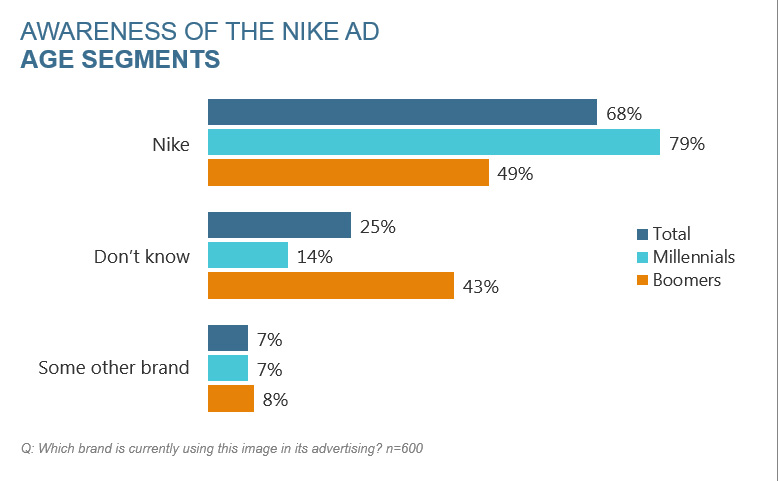
This split between generations becomes even more apparent with the sentiment analysis. The 38% that express negative sentiment towards the ad are overwhelmingly from the boomer segment, where nearly two-thirds state that they have a somewhat or very negative reaction to the ad. By contrast, more than half of millennials have a positive reaction to the ad, and only 16% express negative sentiment. Interestingly, both millennials and boomers are less likely to be neutral when it comes to segment, clearly indicating that it is the younger and older generations that are more polarized, while Gen X is holding the middle ground.
This shows us that despite any negative backlash you might see in the media or online, Nike is generating not only awareness but also strongly net positive sentiment within the market segment that matters most to its revenue today and to the long-term value of its brand.
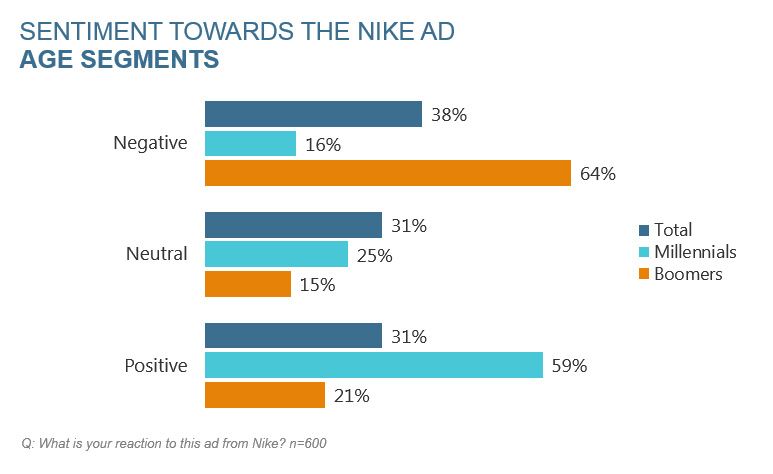
But what about those Nike boycotters and sneaker burners? Well not surprisingly, this generational divide continues when it comes to the anticipated reaction to the Nike advertising. The boomers are the most likely to boycott Nike (44%), and 1 in 10 of them expect to destroy their Nike gear. By contrast, a quarter of millennials suggest that they will either show support to Nike or be more likely to purchase Nike products, while only 1 in 10 would support a boycott and just 1% are cutting up their Nike gear.
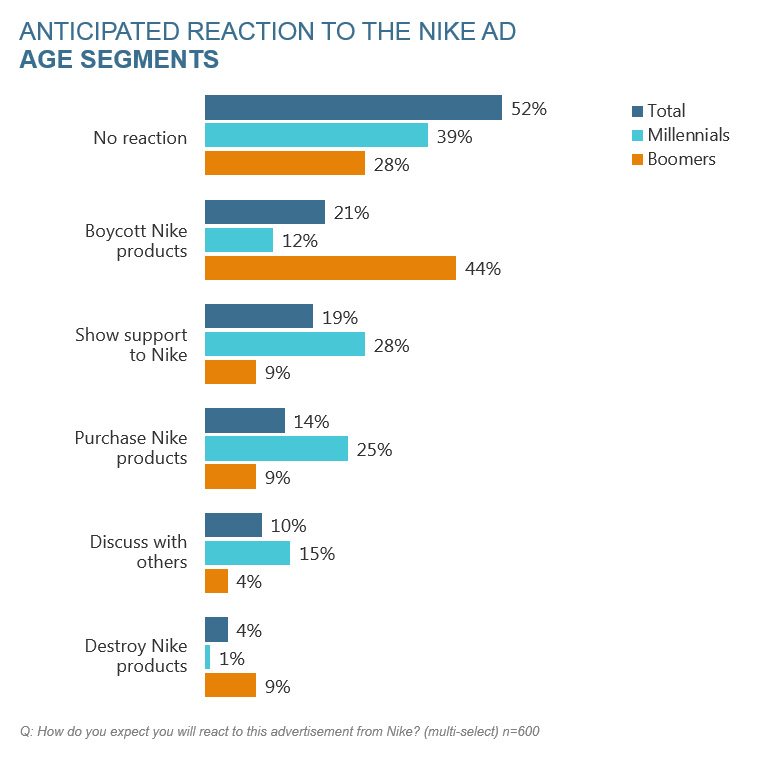
Verdict: A moment of brand genius for Nike
When evaluating this data, the verdict on whether the Kaepernick advertising is a marketing success or PR disaster is clear: This was (another) moment of brand inspiration for Nike. As they look to catch the eye of millennials and Gen Z and excite them with their brand, this campaign is highly effective at raising awareness and positive sentiment. Certainly, there are “casualties” in the form of boomers that have a much more negative sentiment, but ask yourself what Nike cares more about: Evoking passion within what is already its largest customer segment today and undoubtedly the future of its brand for decades to come, or risking few over-55s setting their old sneakers alight.
The answer is clear. This is a moment of brand genius for Nike.








